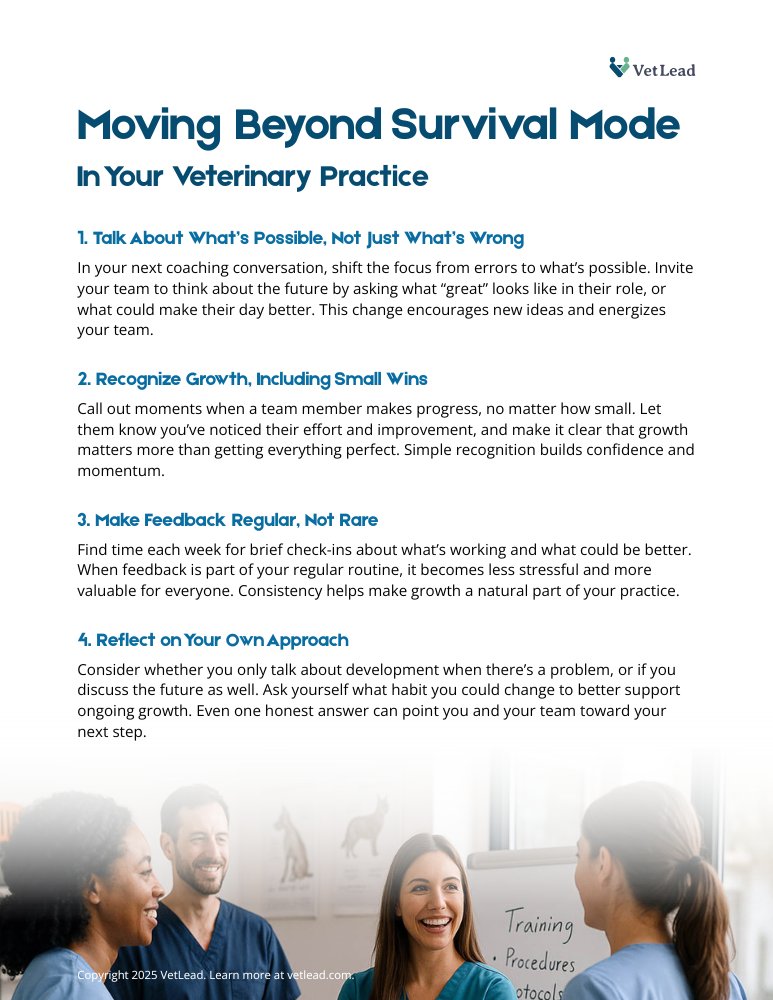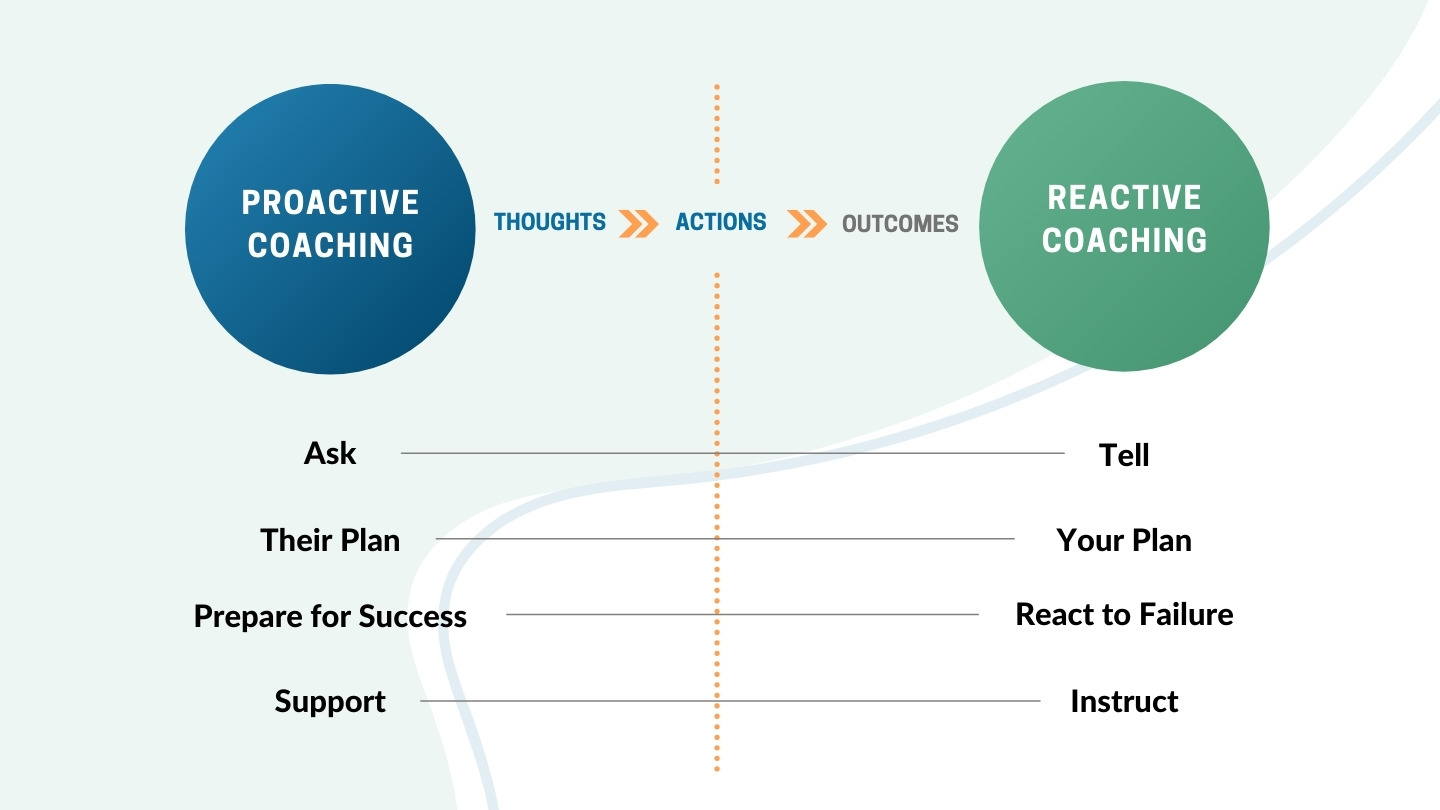Training is a word we use a lot in veterinary medicine. It usually means we take someone new, give them a pile of information, run them through a checklist, and hope they’re ready to work. But in most practices, training ends up being treated like a finish line instead of a starting point. That’s one of the big reasons why practices get stuck, why teams struggle, engagement fades, and mistakes keep happening.
If you’ve ever wondered why so many talented people plateau, or why you spend more time putting out fires than actually building a stronger team, you’re not alone. Let’s take a look at why the old way of doing things holds us back, and what you can start doing differently right now.
The Training Trap: Why One-and-Done Doesn’t Work
After that initial burst of training, there’s an assumption that the work is done. We check the boxes, hand over responsibilities, and expect things to run smoothly. But what often happens is that team members are left on their own to figure out the rest. When mistakes show up later, it’s easy to feel frustrated or even start blaming the individual, rather than recognizing that real learning doesn’t stop after onboarding.
Once that initial push is over, it’s easy for leaders to step back and expect the team members to handle things on their own. When things don’t go as planned, frustration starts to build. Questions like, “Why aren’t they getting it?” or “Didn’t we already train them?” come up, and the conversation quickly shifts from being supportive to being critical. The team member is left feeling like they’re the problem.
When we treat training as something that’s finished, it puts all the responsibility for improvement on the individual. The organization steps out of the development process, and people are left to just survive their day, instead of looking for ways to grow and do their best work.
Living in Survival Mode: The Cost to Your Veterinary Team
When training is just an event, learning quickly grinds to a halt. Day after day, team members repeat the same tasks, face the same challenges, and rarely get the chance to build new skills or confidence. What you end up with is a team stuck in survival mode.
What does survival mode look like?
- Coaching conversations only happen when something goes wrong.
- Team members hear about their mistakes, but not about their growth or potential.
- Frustration grows - on both sides - when errors repeat themselves.
- Disengagement sets in. People stop looking for ways to improve and just hope to get through the day.
It’s a draining cycle, and one that leads directly to burnout and turnover. Veterinary medicine is already a high-pressure environment. If people don’t see a path to growth, they either check out mentally or decide to leave altogether.
The Problem-Fixing Mindset (And Why It’s Not Enough)

Most practices fall into another trap: the belief that our main job as leaders is to fix problems. We spend our days reacting to whatever’s broken: missed appointments, mistakes in medication, team members running late, conflicts with clients.
Of course, these issues need attention. But if all we do is play whack-a-mole with problems, we miss the bigger opportunity: building a team that’s actually growing, not just trying to avoid the next mistake. It’s hard for people to care about development if the only time they’re called into the office is when something’s wrong. Imagine doing 100 things right in a day, and only hearing about the one thing you missed. That’s discouraging, and it shapes the culture in a way that’s hard to recover from.
Our brains are wired to notice threats and errors because in the wild, missing a threat could be fatal. But in a veterinary practice, this survival mechanism keeps us focused on the past, not the future. It keeps the entire team locked in a loop of “what went wrong” instead of “what could go right.”
Shifting from Veterinary Team Training to Growth Changes Everything
Veterinary teams that thrive are the ones where learning and improvement never stop. Growth isn’t a checkbox; it’s a way of operating every day. When leaders prioritize ongoing development, the benefits are obvious:
- Team members feel more energized and motivated.
- Engagement and accountability improve.
- Retention goes up, because people see a future for themselves at your practice.
- Mistakes still happen, but people learn from them instead of just fearing them.
Shifting to a growth mindset means that you see development as continuous, not a one-time event. It means that you invest time in helping people get better, not just when something breaks, but because that’s how your practice gets stronger over time.
How to Start Moving Beyond Survival Mode In Your Veterinary Practice

Move Beyond Survival Mode
Download this free PDF and share it with leaders and teams. No email address required.
Most veterinary practices deal with these challenges. The good news is, you can start making small, immediate changes that will begin to shift your culture from “just survive” to “let’s grow.”
Here are a few places to begin:
1. Talk About What’s Possible, Not Just What’s Wrong
Next time you have a coaching conversation, don’t just address errors. Ask questions like, “What would great look like in this role?” or, “If you could change one thing about your day to make it better, what would it be?” These questions invite your team to think about the future, not just the past.
2. Recognize Growth, Including Small Wins
When you see a team member making progress, however small, call it out. “I noticed how you handled that client’s concerns: much smoother than last month.” Recognition for growth builds momentum, and it shows people that improvement matters more than perfection.
3. Make Feedback Regular, Not Rare
Don’t wait for big mistakes or annual reviews. Carve out a few minutes each week to talk about how things are going, what’s working, and what could be even better. The more normal these conversations become, the less intimidating they feel.
4. Reflect on Your Own Approach
Ask yourself:
- Do I only have development conversations when things go wrong?
- How often do I talk to my team about their future, not just their performance?
- What’s one habit I can change this week to support ongoing growth?
Even one honest answer can show you where to focus your next step, and where growth might begin for your team.
Looking Ahead: Turning Mindset into Action
Changing the way you approach development won’t happen overnight. It’s a process, and it starts with awareness and a willingness to try something new, even if it feels a little uncomfortable at first. Remember, you’re not aiming for perfection. You’re aiming for progress.
In the next post, we’ll look at how to turn this mindset into daily practice using Individual Development Plans. You’ll learn exactly how to create a structure for continuous growth that works in real veterinary practices; not just on paper, but in daily conversations with your team.
If you’re ready to stop surviving and start building a stronger, more engaged team, make one small shift this week. Focus on growth, not just gaps. Notice what’s possible, not just what’s broken. See what changes for you and your team.
What do you think? Other veterinary pros want to hear from you! Share your experience in the comments below.
